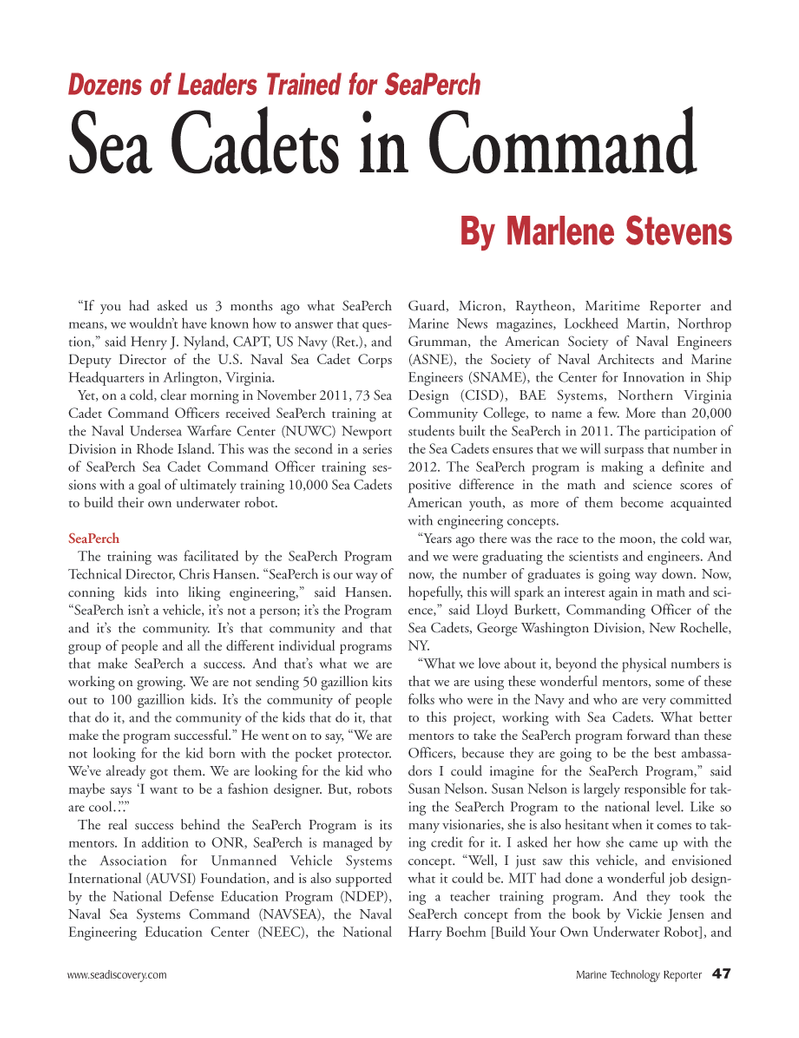
Page 47: of Marine Technology Magazine (May 2012)
Hydrographic Survey
Read this page in Pdf, Flash or Html5 edition of May 2012 Marine Technology Magazine
www.seadiscovery.com Marine Technology Reporter 47?If you had asked us 3 months ago what SeaPerch means, we wouldn?t have known how to answer that ques- tion,? said Henry J. Nyland, CAPT, US Navy (Ret.), and Deputy Director of the U.S. Naval Sea Cadet Corps Headquarters in Arlington, Virginia. Yet, on a cold, clear morning in November 2011, 73 Sea Cadet Command Officers received SeaPerch training at the Naval Undersea Warfare Center (NUWC) Newport Division in Rhode Island. This was the second in a series of SeaPerch Sea Cadet Command Officer training ses- sions with a goal of ultimately training 10,000 Sea Cadets to build their own underwater robot. SeaPerch The training was facilitated by the SeaPerch Program Technical Director, Chris Hansen. ?SeaPerch is our way of conning kids into liking engineering,? said Hansen. ?SeaPerch isn?t a vehicle, it?s not a person; it?s the Program and it?s the community. It?s that community and that group of people and all the different individual programs that make SeaPerch a success. And that?s what we are working on growing. We are not sending 50 gazillion kits out to 100 gazillion kids. It?s the community of people that do it, and the community of the kids that do it, thatmake the program successful.? He went on to say, ?We are not looking for the kid born with the pocket protector. We?ve already got them. We are looking for the kid who maybe says ?I want to be a fashion designer. But, robots are cool? ??? The real success behind the SeaPerch Program is its mentors. In addition to ONR, SeaPerch is managed by the Association for Unmanned Vehicle Systems International (AUVSI) Foundation, and is also supported by the National Defense Education Program (NDEP), Naval Sea Systems Command (NAVSEA), the Naval Engineering Education Center (NEEC), the National Guard, Micron, Raytheon, Maritime Reporter and Marine News magazines, Lockheed Martin, Northrop Grumman, the American Society of Naval Engineers (ASNE), the Society of Naval Architects and Marine Engineers (SNAME), the Center for Innovation in Ship Design (CISD), BAE Systems, Northern Virginia Community College, to name a few. More than 20,000 students built the SeaPerch in 2011. The participation of the Sea Cadets ensures that we will surpass that number in 2012. The SeaPerch program is making a definite and positive difference in the math and science scores of American youth, as more of them become acquainted with engineering concepts.?Years ago there was the race to the moon, the cold war, and we were graduating the scientists and engineers. And now, the number of graduates is going way down. Now, hopefully, this will spark an interest again in math and sci- ence,? said Lloyd Burkett, Commanding Officer of the Sea Cadets, George Washington Division, New Rochelle, NY. ?What we love about it, beyond the physical numbers is that we are using these wonderful mentors, some of these folks who were in the Navy and who are very committed to this project, working with Sea Cadets. What better mentors to take the SeaPerch program forward than these Officers, because they are going to be the best ambassa- dors I could imagine for the SeaPerch Program,? said Susan Nelson. Susan Nelson is largely responsible for tak- ing the SeaPerch Program to the national level. Like so many visionaries, she is also hesitant when it comes to tak-ing credit for it. I asked her how she came up with the concept. ?Well, I just saw this vehicle, and envisioned what it could be. MIT had done a wonderful job design- ing a teacher training program. And they took the SeaPerch concept from the book by Vickie Jensen and Harry Boehm [Build Your Own Underwater Robot], and Dozens of Leaders Trained for SeaPerchSea Cadets in Command By Marlene StevensMTR#4 (34-49):MTR Layouts 4/27/2012 9:48 AM Page 47

 46
46

 48
48
